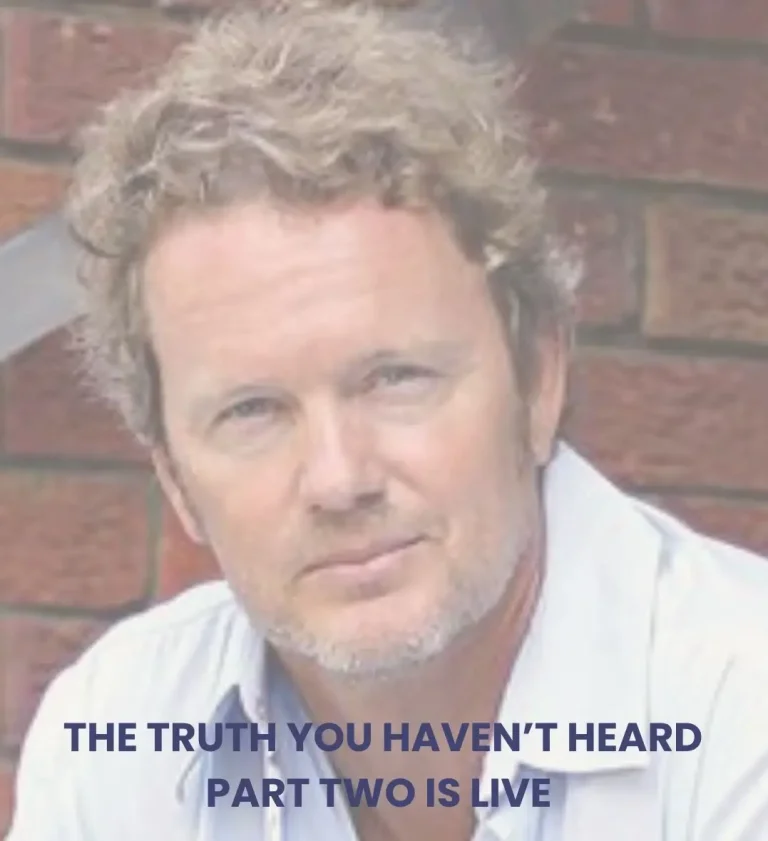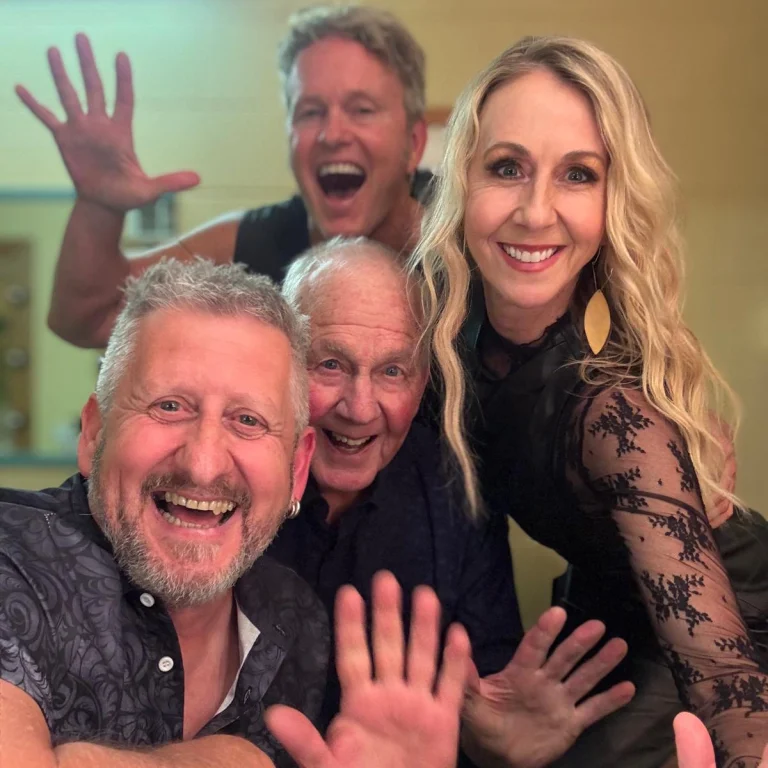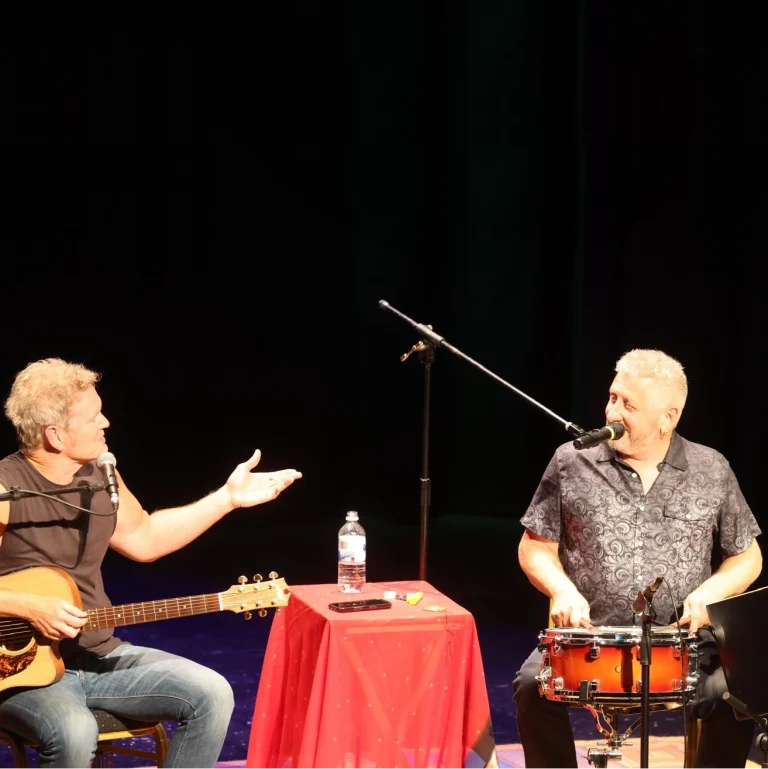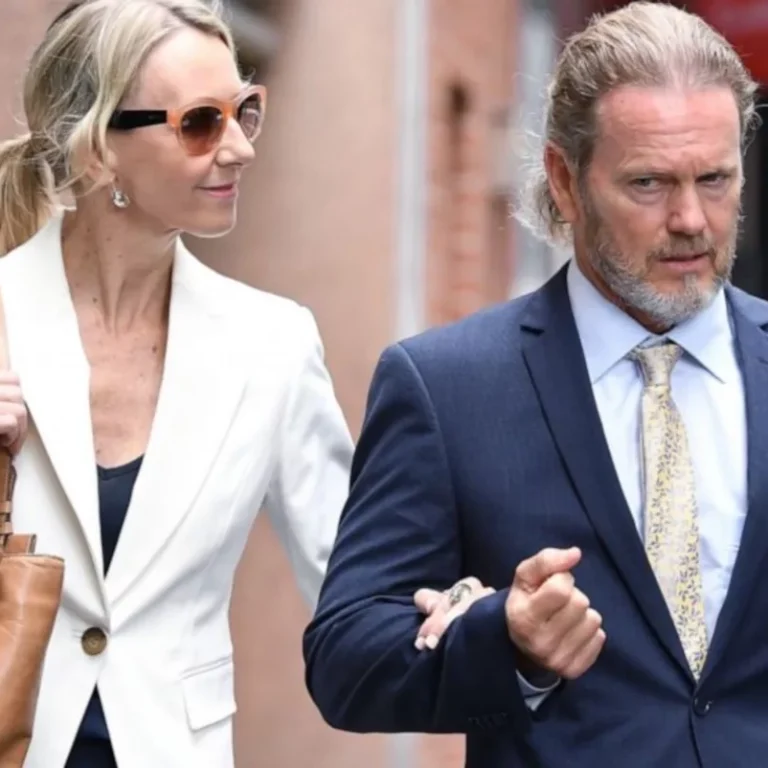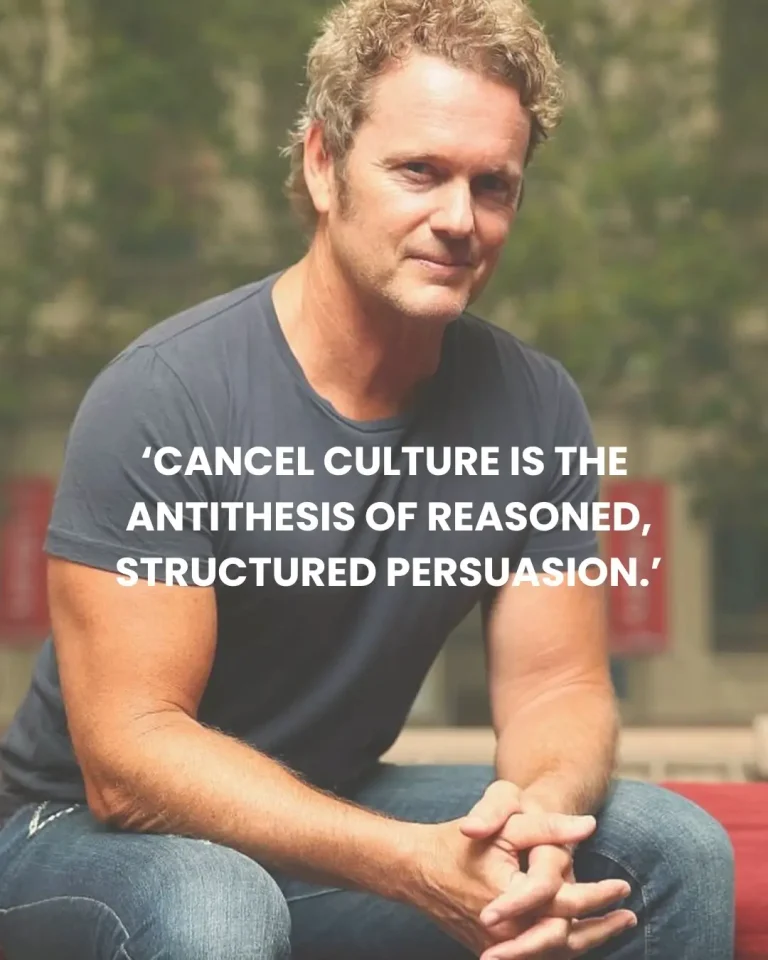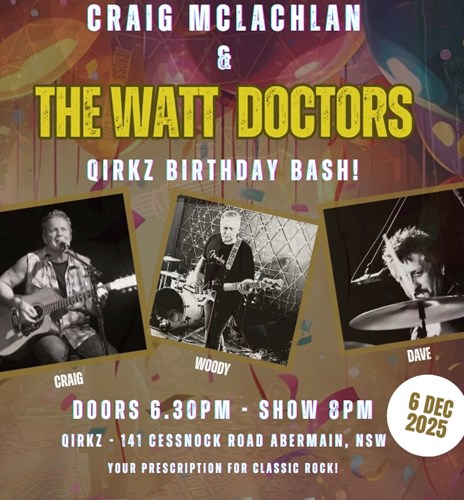Loss of the Presumption of Innocence Conference, Sydney 2024
At the Loss of the Presumption of Innocence Conference in Sydney, 2024, Vanessa Scammell — acclaimed conductor and partner of actor Craig McLachlan — delivered a deeply personal and powerful talk. In her address, she shared her first-hand experience of the devastating impact false allegations and trial by media can have, not only on the accused but also on their loved ones.
Her story is a stark reminder of what can be lost when due process is replaced by public judgment, and why the presumption of innocence remains a cornerstone of justice that must be protected.
This feels like the right time to share this here.
x Team Craig
Transcript: Loss of the Presumption of Innocence Conference, Sydney 2024
Talk by Vanessa Scammell
Almost 7 years ago, in early October 2017, my partner and I were walking along a Sydney street when a good friend and colleague ran out of a café to greet us.
Four years earlier my partner and this friend had performed together in a professional production of an iconic music theatre stage show. She hugged us, held our hands and told us both how much she had loved working with my partner on a TV series over the past two years – a series which had just finished airing. She gushed: “It was the best time of my life.”
Only months before, she had sent my other half a photo of herself sitting on a toilet, with her red underpants pulled down around her knees as part of a joke.
I had also received a text message from her around that time:
“Oh Ness, we were out of control together. Not going to lie, Nikki and Erik (these being their TV character names) hosting a TV show together is gold. We laughed and laughed. Hope you’re wonderful. Can’t wait to see you soon. xxx love, love, love”
She left us on the street with more hugs and with a promise to meet up for dinner.
Eight weeks later, on 8 January 2018, a story broke that decimated the life I once knew. Three women from the 2014 Rocky Horror Show had gone to the press to accuse my partner of bullying, intimidation, harassment, and indecent assault in the workplace. Our “friend” was one of the three women.
My name is Vanessa Scammell and my partner’s name is Craig McLachlan — a Gold Logie, ARIA and Helpmann Award winner, and one of Australia’s most popular actors and personalities.
Today, I ask you to listen to Me Too as I share my experience of what happened in the wake of that fateful day. Much of this you will be hearing for the first time, for as I have discovered, accusations make much better news than an exoneration.
The story I tell centres around a vicious public lynching. It’s a story about mobbing, betrayal, abandonment and duplicity — but most of all, excruciating emotional pain and distress.
The story I tell involves a movement that has eroded the cornerstone of the most basic of human rights: the presumption of innocence.
As a tall poppy, Craig was an easy target when the requirement was to find a poster boy for the Me Too movement in Australia — flirty, over the top, charming, funny, irreverent, occasionally seen in roles wearing next to nothing as the characters demanded, and the clincher… a big personality.
I am here to speak of the carnage that is wreaked upon an accused person, their partner, families and friends, brothers and sisters, mothers and fathers, sons and daughters when guilt is assumed, when fair process is relegated to second place, and when certain groups of the media and social media run public assassinations without nuance, care, or humanity — let alone tested and tried hard facts and evidence.
The “believe all” mantra that was associated with the frenzy of activity back in 2017 still lingers — and carries a dark and dangerous side when men are falsely accused. Accusations of this kind are often complex, but they can also be used to promote fear and cause irreparable damage.
Fear, because we are told we must believe. Fear, because if you don’t comply and publicly support accusers, you will be damned and cancelled along with the very people who have had allegations made against them.
I am not here to diminish the experiences of women who have been through untold pain and horror. I am here to tell of my experience, and to discuss the particulars of the nightmare in which I became unwittingly involved.
What is not widely known is that I toured with Craig for the entire 2014 Rocky Horror run. I was in the theatre, in Craig’s dressing room on an almost nightly basis, spending time with the cast, and predominantly our former friend.
My personal experience of the show, and who Craig McLachlan is as a person, simply does not match the narrative that was painted by the press and Craig’s accusers back in 2018.
The most distressing part of this tale was the clandestine and underhand way supposed friends, colleagues and the press collaborated to ensure Craig’s annihilation. For prior to this, there had NEVER been any indication made to Craig or me that anything was amiss.
In fact, quite the opposite. Years of friendly communications… “It’s such a pleasure working with you Craigie.” “Darling, sending love to you and Ness.” … the list goes on.
There had never been a complaint made about Craig involving sexual harassment or indecent assault to the management, creative team or producers during the Rocky Horror tour of 2014. Not in 2015, not in 2016. Not until the remounted show of 2017/18 when the new cast was announced. When, coincidentally, none of Craig’s accusers who had applied, auditioned or been approached were successful in being recast.
The secret and strategic planning of when the story was to be released seemed to be at odds with the accusers’ claims that “they only came forward to protect the new female cast members of the show.” For they hadn’t come forward to protect cast members during the 2014 show. They hadn’t come forward for the new cast members in the 2015 tour.
But more than two months after the 2018 cast was announced, after the rehearsal period had completed, after the Christmas break, after the show had opened in the New Year of 2018, they most certainly came forward.
Later, it became clear that the timing of the release of the story was calculated to maximise the damage to Craig — to wreck his career, destroy his reputation, and inflict as much pain and humiliation as humanly possible.
One of the journalists said it all: “Ultimately we want him out of that job.”
These prophetic words were uttered before contact had ever been made with Craig, by a journalist who had never met him or directed a single question to him in relation to the allegations — but she had decided he was to be removed.
The first communication we had from journalists was on 4 January 2018, when Craig received an email outlining broad allegations asking for his response. His accusers were not named. With horror and desperation, he asked the journalists: “Who are these people making such heinous allegations?” No answer was forthcoming.
We had no idea as to who these people might be until four days later — when the story hit the press in the biggest showbiz way imaginable.
Australia’s golden-haired boy from Ramsay Street was obliterated.
Front and centre was our former friend, alongside two other cast members — with dressed-down, dour appearances in contrast with images of Craig in lascivious poses as the star of the show — Frank N Furter, complete with curled lip, corset, high heels, fishnets and lipstick.
The result? Without any official investigation, due process, or consideration of his 30-year stellar career, Craig was cancelled from everything he was a part of. He stepped down from the Rocky Horror Show. He was removed from his hit TV series The Doctor Blake Mysteries. Projects that were in the pipeline with other networks vanished. Shows that he had appeared in and that were airing on TV at the time were removed.
It became obvious that in the procuring of a scoop like this, beyond the demolition of the main target, there was zero thought for anyone caught up in the collateral damage. In my story, there was certainly no consideration for any of the women in Craig’s life. The contradiction is quite sickening. Society sees the arrival of a movement that fiercely sells itself as being all about women…
But in the hunting and ultimate public slaughter of my partner, there was zero consideration for his 90-year-old mother, his nieces, his sisters… There was zero consideration for a woman like me.
How could the media have run with such a vicious story? From no complaint in a 35-year showbiz history to this.
But we now live in a time where allegations alone are enough to destroy a person in an instant.
What were we to do?
Well, we launched a David vs Goliath defamation suit against the publications who ran the story.
A date for the matter was set for 19 January 2019. And I note — that it wasn’t until we were well and truly embedded in the ugly, slippery slope of defamation law, that we realised that defending yourself against massive media behemoths is thoroughly ruinous, both fiscally and emotionally.
Two weeks out from the hearing, the punches kept rolling in. The Victorian DPP charged Craig with 8 counts of indecent assault, common assault and a charge of attempted indecent assault. Six months later, several charges were dropped, but they doubled up the indecent assault charges with common assault, effectively giving themselves a double dip for conviction.
Two years after the initial allegations, in November 2019 the criminal case finally began. Running for three weeks, the complainants and witnesses gave their evidence — but the allocated time had run out for Craig to take the stand. The matter was rescheduled for April 2020.
And so, we waited.
Just weeks out from the hearing, catastrophe again hit — COVID. The legal system shut down overnight and Craig’s chance to give evidence was postponed until November 2020. An entire year after the women had given theirs.
And so, we waited.
In November 2020, Craig gave his evidence, and the case was finally closed. Six weeks later, on 15 December, Craig McLachlan was acquitted of all charges. One hundred percent NOT GUILTY.
The Victorian Police were ordered to pay Craig’s costs. There is nothing like a half-million-dollar payout to indicate that Craig should have never been prosecuted in the first place.
Justice! At last, the victory and verdict we had waited for, for three long years.
But it wasn’t going to be smooth sailing. Not at all. For the injustice of justice reared its ugly head in the form of the ruling Magistrate’s comments.
Although she had found Craig NOT GUILTY on all charges, she added the defendants were “brave and honest.”
And further — that: “Were the current laws applicable, it is possible that the result may be different.”
It is POSSIBLE that the result MAY be different.
The Magistrate, delivering her comments to a packed online media gallery, must have known exactly the furore she would create with such explosive and inflammatory commentary.
Having studied the rulings, I discovered that her comments about “different laws” related specifically to just two of the 14 charges, and even then, practising lawyers didn’t believe there was a big difference between this way of evaluating consent and how it was assessed under previous laws.
But was this made clear? No.
Instead, this was delivered as a blanket statement in her final rulings, suggesting that all charges possibly or may have been different. Thus, more headlines and commentary ensued that were used in attempts to diminish Craig’s NOT GUILTY verdict.
It begs the question: what is the responsibility of any magistrate presiding over any case once the verdict has been delivered? One would have to argue that it is NOT the responsibility of a magistrate to offer up grandiose and inflammatory scenarios based on or around personal beliefs. The ultimate requirement of any officer of the court surely is to exercise professionalism, not make deliberate post-acquittal commentary in a heroic tone.
In the courtroom Craig’s accusers were known as “victims” and were addressed by their first names — or titles and surnames.
Craig was known as “the accused man.”
The “victims” were granted anonymity, their names protected under a closed court order. They were able to give evidence in camera and to have court-appointed support people accompany them.
Craig was not permitted to have a support person.
Even after presenting documentation by a medical health professional outlining Craig’s fragile mental state, the Magistrate ruled that — and I quote — “Craig had enough people in his legal team to support him.”
I always thought that barristers and solicitors were there to provide legal counsel, not psychiatric and emotional support.
So, what rights does an accused person have in court?
Innocent until proven guilty, right?
It didn’t feel like it.
Each day upon entering the court we were faced with a barrage of media armed with cameras and microphones, shouting out questions as we tried to make our way in.
We sat in the waiting area of the court with alleged carjackers, thieves, and drug traffickers. Many of them nicer than the people we’d regrettably considered “friends” for years — and all of them rooting for Henry.
Although I was prevented from sitting in the closed court, I attended every open court session, and it became apparent to me that Craig was tried as “Frank N. Furter” — the extrovert, over-the-top, centre-of-the-universe fictional stage character — not Craig McLachlan.
It seemed that not only his peers, but also officers of the court, were unable to separate the character from the man.
The Magistrate also demonstrated a desire to paint the women in a positive light, even in moments where she ruled that they were “prone to exaggeration” or “confused” or “mistaken.”
An example is when one of the complainants was described as “playful… a bit wicked.”
Even after being presented with evidence that this cast member was front and centre when it came to joking and mucking around — that her humour was sexualised and shocking. That she would pinch Craig’s backside, give him and another male colleague “wedgies” during performance, pull down Craig’s shorts, openly discuss her genitalia, and speak in cruel and vulgar doggerel about her female colleagues.
On the other hand, Craig was described by the Magistrate as having an “egocentric state of mind” — that he was “self-entitled, with no checks or balances.”
I would be forgiven if I thought the Magistrate had simply googled the character breakdown brief for Frank N. Furter, for these are the very words that are used to describe the character of Frank — the cross-dressing, sweet transvestite from Transsexual Transylvania.
After the case, the Magistrate was investigated due to a series of complaints about her conduct as an officer of the court. She was found to be within the law, but her questionable legal comments and rulings were not part of the investigation.
Throughout this, one of my biggest questions has been: How is a decision to lay charges made?
The author Sentry One sums it up with this quote:
“In high profile cases in Australia, the ‘seriousness’ of an alleged offence appears to factor in a blinding, and extraneous #MeToo phenomenon, allowing for the consistency in the DPP’s decision-making to be eroded by what the public defines as ‘public interest’.”
In laying charges, it is the duty of any prosecutor to “look beneath the surface of the matter,” and only then — if they are satisfied that there is sufficient evidence to justify a prosecution — must they decide “whether the public interest requires a public prosecution to be pursued.”
When charges are laid, bound by law, the prosecution must establish to a criminal standard that the average right-minded person would consider the allegations so offensive to current community standards as to be indecent.
Which leads me to the community standards of the 2014 Rocky Horror Show.
As Craig’s barrister submitted:
“Backstage at the Rocky Horror Show with the cast ‘getting around nearly naked in fishnets and briefs’ is not the same environment as a school speech night.”
And further — there was a great deal of physical “mucking around”: ostensibly affectionate, overtly suggestive — camping it up, goosing, provocative poses, lap-sitting in the wings, hugs and kisses, a constant stream of dirty jokes, insincere protestations of admiration and undying love, showing-off, sexual suggestion, nipple tweaks… and all of it de rigueur.
Yet there was a refusal by the complainants to countenance any of Craig’s hyperbole, pranks, or jokes. Instead, they chose to place a morbid construct on each experience and interaction they had with him — portraying him as a lone wolf behaving in an egocentric manner backstage, separate to all others.
And what about intent?
For someone to be convicted, the prosecution must prove that the accused intended to act out an assault knowing that the person was not consenting.
How could sitting on someone’s lap be considered an assault when it was common practice within the entire cast?
When the cast member who made the allegation of lap-sitting was herself photographed straddling Craig’s thigh just weeks before the show ended?
And herein lies the danger.
The danger of information that is intentionally and conveniently left out.
The danger of not understanding the context of the community in which all these actors were a part.
For without context, the truth can be manipulated, distorted, and twisted to suit the desired narrative.
Further, how does one tell the full story when a closed court order is in place?
What happens when open justice cannot be achieved?
I recently wrote to the Principal Registrar of the Victorian Magistrates Court, enquiring about obtaining permission to access closed court materials.
I noted in my letter that one of the complainants had publicly revealed her identity on multiple platforms, and that she had been part of the criminal case.
This was ignored in the response I received. Rather, my attention was drawn to the fact that closed court orders are necessary to “avoid causing undue distress or embarrassment to a complainant or witness.”
What about the embarrassment and distress of an accused person?
The accusers remain protected, labelled as “victims,” and yet there is nothing in place for the accused man who now finds himself acquitted and unable to tell the full story.
Should people who go to the press with untried allegations be protected by the courts?
As the lawyer Rebecca Giles stated:
“There are cases where malicious lies are concocted by a party with the sole intent to damage an accused. The accuser — even when faced with clear evidence of dishonesty — walks away from the devastation caused with the protection of anonymity and little remorse, having achieved their intended objective of publicly smearing the reputation of the accused, who is left emotionally and financially depleted.”
Let me take a moment now to share some of what we experienced.
As the complainants’ names are protected under Victorian law, I will refer to them as C1, C2, and C3.
C2 initially relayed several stories about her best friend, who was also in the 2014 production. She said that during a scene, Craig had removed her friend’s underwear, kissed her on her private parts, and groped her.
Under cross, she swore adamantly that her best friend had told her this, making these allegations very serious indeed. But, when these claims were presented to the best friend — the alleged victim — each and every claim was rejected by her as being false; she agreed the claims were “lies” and “grossly untrue.”
It never happened. Yet these contrived allegations were made to journalists, incorporated into C2’s police statement, and were referenced in the initial email that Craig received, which became part of sensational headlines.
This “brave and honest witness” had clearly fabricated a most dishonest story.
C2 also gave a detailed description in relation to a common assault charge that she had allegedly witnessed during a scene whilst on stage on May 9, 2014. During cross, it was revealed that C2, on the evening in question, had in fact left the stage before this scene was performed and did not return for the remainder of the show.
But more perplexing than this falsity was that the Magistrate went on to suggest in her rulings that perhaps C2 had been able to witness this assault from the wings — a suggestion that C2 certainly hadn’t made, and a comment that shows gross ignorance not only about the geography of the set and the backstage area, but more worryingly, since when does a Magistrate offer up alternative evidence?
In court, C3 spoke of a dressing room feud that led to her being relentlessly bullied for the entire tour. In January 8 publications, it was printed that Craig was the bully of the RHS. But under cross, C3 admitted the bully was not Craig. In fact, he had been kind and supportive. She eventually disclosed under oath that she’d been relentlessly bullied by her female castmate C1.
Conveniently leaving out this information to the press and to the police was far from “brave and honest” — it was disingenuous and intentionally obfuscating.
C3 also claimed she had witnessed Craig go up behind C1 during a cast warm-up, that he laid behind her with his hand on her hip, moving his hips into her lower back. Craig was charged with assault based on her allegation.
But had C1 been assaulted? The journalists had asked C1 about it — and her response? That hadn’t happened. Craig hadn’t done what was alleged. And so, the charge was eventually thrown out of court. But was this explained clearly in the press? No. It was not. And in any case, it’s all too little, too late.
Based on “the evidence” — or rather “the complete lack of” — how could this charge have been laid? Please, someone tell me.
But the worst of the claims was the allegation made by C1, an allegation Craig vehemently defended.
In an early interview, C1 stated:
“I didn’t know it was sexual harassment, I didn’t know how inappropriate it was because it was always a joke.”
But four years later, when Me Too hit, suddenly it became crystal clear to her.
She alleged that during the Rocky Horror bed scene — a scene in which the characters are viewed standing in an upright bed — at a definitive point, where she claims she was “directed” to face the audience with her hands on the covers (which were about chest height), Craig momentarily disappeared, and whilst crouched down in front of her, assaulted her.
When this allegation was published, it included an online video clip featuring a snippet from the bed scene. The clip showed C1’s hands resting above the set as she claimed, Craig crouching down next to her, her hands remaining on top of the covers as he disappeared from view.
But what has never been revealed until today is that the footage they used was not taken from an actual performance of the 2014 show. It was, in fact, footage of the bed scene, tweaked and redirected specifically for use in a TV commercial. Characters repositioned for the camera! Positions that were never part of the actual production.
When actual archival footage of the show was viewed in court, it evidenced serious discrepancies in C1’s claims:
There was never a moment in the scene where her hands were directed to sit above the set whilst Craig was out of sight.
There was never a moment in the scene where Craig was directed to be crouched down directly in front of her.
C1 unequivocally agreed that there was no difference between the way the scene was captured on the archival video and how it was typically performed each and every night — i.e., the audience watched the bed scene exactly as it played out on the video.
In every performance, in the alleged moment Craig drops from sight, she has her back turned to him. In other words, she had been “directed” to turn away from him, with her back facing him, before he crouched down out of sight.
After viewing the archival footage, she was asked to do her best to name the precise moment in the scene where the assault had occurred.
Obviously, it couldn’t be in the moment where her back was facing him, so another moment was chosen — the only other “directed” moment where Craig crouched down out of sight. However, during this moment, Craig was at the far right-hand side of the set, around two metres away from where C1 was positioned at the far-left end of the set, separated not only by distance but also by an adult-size prosthetic leg and a stagehand.
Yes, a living, breathing human being was physically part of this moment of the show each and every night — and yet, believe it or not, the police did not ever call him to give a statement.
And so, in this newly chosen moment, not only was Craig not crouched in front of her, her hands — rather than resting on the bedcovers as she claimed — were in fact directed to handle and swing the prosthetic leg in Craig’s direction while he maintained a safe position out of striking distance!
Note that none of this evidence presented in C1’s cross or given by Craig was challenged by the prosecution.
So why hasn’t any of this information ever been reported? Why was Craig’s evidence not considered to be in the public interest? He gave his evidence in an open court.
Forgive me for believing that Me Too has pervaded the law and justice system.
Forgive me for believing that charges are now laid simply and purely because someone has “said” it happened.
Forgive me for having no faith in the Victorian police or the DPP, who seemingly didn’t bother with rigorous investigation before charges were laid.
Why aren’t there consequences for people who abuse the system of law? Where is the accountability for lying in court?
When exaggerated or false claims are made to police, why are these individuals not investigated and/or charged?
And what are the consequences for police and prosecutors when allegations are not thoroughly investigated?
In Craig’s case, the police didn’t even bother to seek out the archival footage of the RHS. Would that not be the first thing they should have done, let alone speak to the relevant crew members who were present at the time of an alleged assault?
It seems unmistakable that the ideology around the Me Too movement is influencing our justice system. Imagine the fallout if the Victorian police and the DPP hadn’t proceeded with criminal action after the press had poured petrol on the so-called public interest story.
WRAP UP
It is very hard to imagine someone being willing to recklessly wreak such devastation on another human being’s life.
Beware if you have a big personality, are florid with declarations of love, are tactile, and have a sense of humour. It doesn’t fit the mould that we are now expected to conform to.
In saying this, I do not suggest for a minute that assault, harassment, intimidation, or bullying is acceptable in any working environment. But neither is it acceptable to retro-fit behaviour and events, to leave out details, to manipulate and distort the truth to suit an agenda or movement — particularly a movement that has seemingly drawn up battle plans to wage war against any man perceived to be in a position of power.
And so, having experienced the very worst of humanity, I will not play the victim card.
I will not be known as a victim.
And make no mistake. Craig is not a victim either.
He is a survivor — and the disconnect between the hugely supportive public and the industry from which he finds himself removed remains devastatingly apparent.
Craig and I survived a criminal matter where he was found NOT GUILTY.
We survived the discontinuance of a civil matter, making the very difficult decision to walk away only when we discovered that the jury was not permitted to know that Craig had been found NOT GUILTY in a criminal matter.
So here I stand, as a survivor, needing to let people know that not all headlines are the truth.
That there are always two sides.
There is what is known as “my truth” and “the truth.” And boy, is it hard to get “the truth” out there.
I would like to think that laws will change, that defendants’ rights will be better protected, that eventually there will be repercussions for people who go to the press before the police.
That the presumption of innocence will be restored.
We have a long way to go — we must be able to have faith in the justice system, yet tragically, for so many Australians this faith has been shattered.
We cannot successfully live in a society where a headline or front page demolishes due process.
And we must not accept a diluted and corrupted version of due process.
Thank you all for listening to Me Too.

